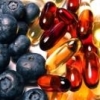Low concentrations of flavonoids are protective in rat H4IIE cells whereas high concentrations cause DNA damage and apoptosis. states that quercetin and fisetin induced cytotoxicity, DNA strand breaks, oligonucleosomal DNA fragmentation, and caspase activation at concentrations between 50 and 250 micromol/L …. Published data on quercetin pharmacokinetics in humans suggest that a dietary supplement of 1-2 g of quercetin may result in plasma concentrations between 10 and 50 micromol/L.
When they say 1-2g doses provide 10-50 uM, they can't possibly be referring to the quercetin aglycone. Probably they are talking about all quercetin metabolites, expressed as a quercetin equivalent. On the other hand, all the scary cytotox, DNA issues etc is undoubtedly in vitro data using the aglycone. In such systems, there isn't a bothersome liver waiting to destroy all the cool xenobiotics you manage to get your hands on...
PublishedDose PlasmaConcentration TargetConcentration TargetDose
8 mg 140 nM 15 uM 5240 mg
20 mg 220 nM 15 uM 3408 mg
50 mg 290 nM 15 uM 2586 mg
80 mg 630 nM 15 uM 1905 mg
1000 mg 1500 nM 15 uM 9750 mg
This table, on the other hand, appears to be talking about the aglycone, based on the nanomolar plasma concentrations they see. None of these are remotely in the ballpark of the doses seen to cause cytotox in vitro.
The genotoxicity in vitro is also worrying to me. No symptoms related to DNA damage has been observed in animal models, but in humans maybe in the very long term this might be a concern.
Based on the low concentrations of the aglycone that are achieved even from large doses of quercetin, I think that a problem is unlikely. We wouldn't be using quercetin long term for senescent cell clearance, so I'm not particularly concerned. Quercetin at dietary doses has very good epidemiology, FWIW.
Edited by niner, 26 March 2015 - 01:43 AM.






















































